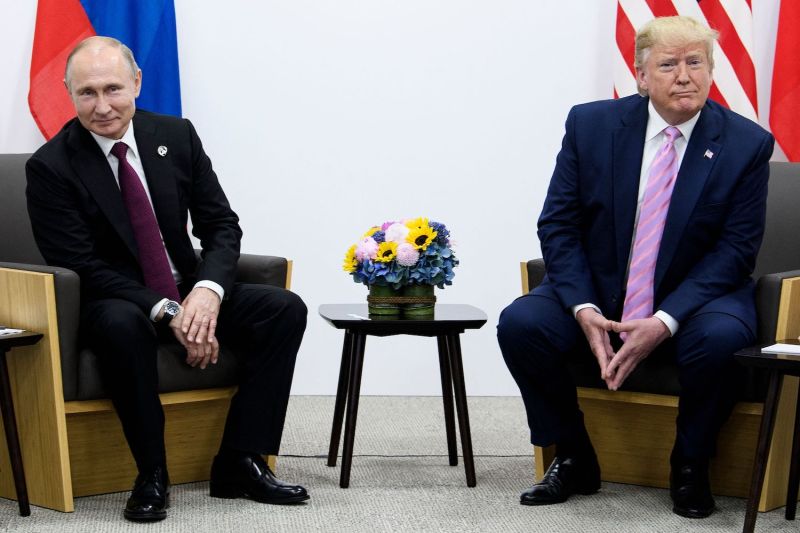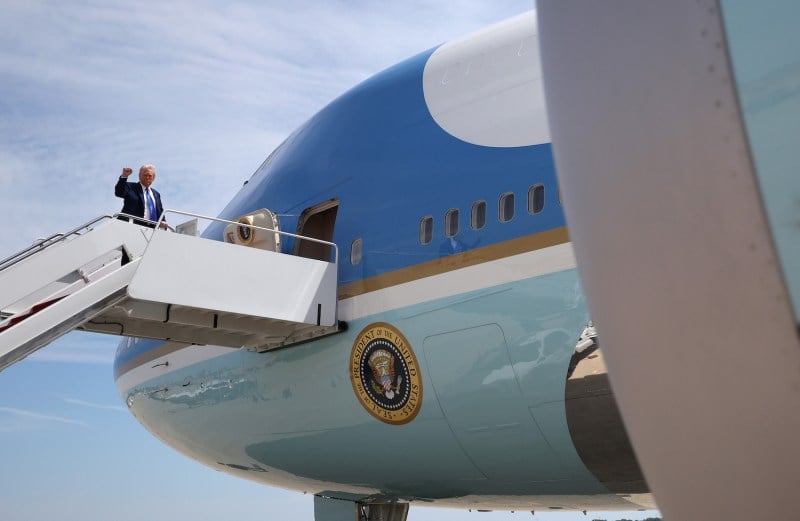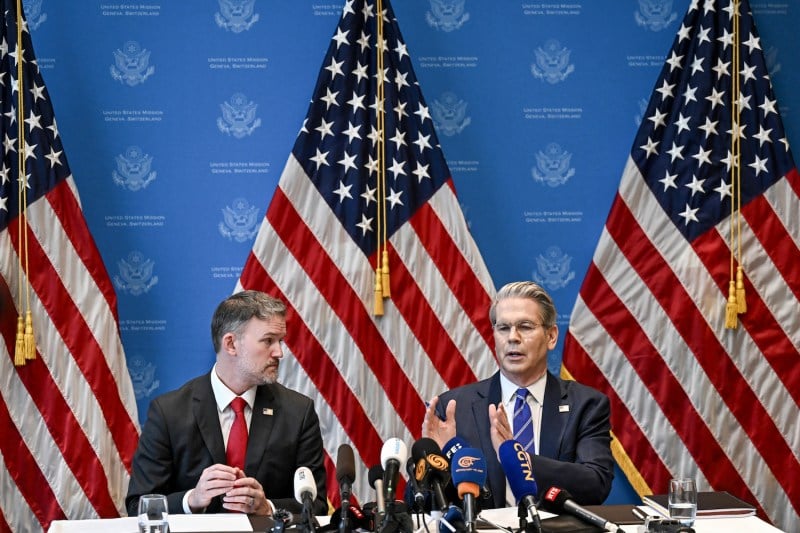How Trump Can Reset His Failed Ukraine Policy

How Trump Can Reset His Failed Ukraine Policy
More pressure on Russia could end the war.
Then-U.S. President Donald Trump attends a meeting with Russian President Vladimir Putin during the G-20 summit in Osaka, Japan, on June 28, 2019. Brendan Smialowski /AFP via Getty Image.
Far from ending the war in 24 hours as he repeatedly promised, U.S. President Donald Trump’s Ukraine policy has been a failure. It has now been more than 100 days, and not only has there been no peace agreement or lasting cease-fire, but Trump has become so frustrated by his inability to deliver a deal that he is now threatening to walk away from talks altogether. Meanwhile, both sides are suffering hundreds of casualties per week along the front lines, and Russia continues to rain down missiles and drones on Ukrainian cities, killing thousands of civilians.
The failure of Trump’s approach was predictable. His assumption was that he could bully Ukraine into giving Russia what it wanted by embracing Russia’s narrative about the war and threatening to cut off U.S. support to Kyiv. But that underestimated both what Russia wanted—Ukraine’s complete subjugation—and a proudly independent Ukraine’s willingness to accept it. Even worse, by failing to include any threat of consequences for Russia if it refused to compromise, Trump gave up much of his leverage without getting anything in return, essentially saying to Moscow, “If you don’t agree with my plan, I’ll walk away and give you everything you want”—not exactly the art of the deal. If a petulant Trump does now walk away from attempts to broker peace, the result will be the indefinite perpetuation of a brutal war; continued threats to Ukraine’s territory, sovereignty, and democracy; and a further blow to Trump’s dream of appearing to be a diplomatic dealmaker.
Far from ending the war in 24 hours as he repeatedly promised, U.S. President Donald Trump’s Ukraine policy has been a failure. It has now been more than 100 days, and not only has there been no peace agreement or lasting cease-fire, but Trump has become so frustrated by his inability to deliver a deal that he is now threatening to walk away from talks altogether. Meanwhile, both sides are suffering hundreds of casualties per week along the front lines, and Russia continues to rain down missiles and drones on Ukrainian cities, killing thousands of civilians.
The failure of Trump’s approach was predictable. His assumption was that he could bully Ukraine into giving Russia what it wanted by embracing Russia’s narrative about the war and threatening to cut off U.S. support to Kyiv. But that underestimated both what Russia wanted—Ukraine’s complete subjugation—and a proudly independent Ukraine’s willingness to accept it. Even worse, by failing to include any threat of consequences for Russia if it refused to compromise, Trump gave up much of his leverage without getting anything in return, essentially saying to Moscow, “If you don’t agree with my plan, I’ll walk away and give you everything you want”—not exactly the art of the deal. If a petulant Trump does now walk away from attempts to broker peace, the result will be the indefinite perpetuation of a brutal war; continued threats to Ukraine’s territory, sovereignty, and democracy; and a further blow to Trump’s dream of appearing to be a diplomatic dealmaker.
There is an alternative, however, that even Trump should be willing to pursue. It would consist of spelling out costs Moscow will incur if it continues down its current path. This would be an excellent project for Trump’s new national security advisor/secretary of state, Marco Rubio, who was once a strong supporter of Ukraine’s independence and right to self-defense. And now is the right moment, ahead of possible direct talks between Russia and Ukraine in Turkey later this week—talks that Ukrainian President Volodymyr Zelensky has pledged to attend in person. Trump himself seems to recognize that diplomacy has reached a critical juncture, proclaiming that this week’s meeting will “determine whether or not a deal is possible” and that if it is not, European leaders and the United States will “proceed accordingly.”
Despite Trump’s enduring reluctance to criticize or impose costs on Russia, a rebalancing of Ukraine policy may not be as implausible as it sounds. Trump has periodically hinted at growing irritation with Moscow and even at the possibility of a new approach that might include “very unpleasant” or even “devastating” things for Russia. After Russian President Vladimir Putin embarrassed him by bombing Kyiv on April 24, just when Trump was hoping to announce progress in negotiations, Trump acknowledged that he was “not happy” with Putin and that the Russian president might be “tapping” him along. Last Thursday, Trump added a threat of new sanctions on Russia, coordinated with U.S. partners, if Moscow does not agree to an unconditional 30-day cease-fire. Putin said over the weekend he was ready for direct talks but ignored the demands for a cease-fire.
Meanwhile, Trump’s disastrous relationship with Zelensky has improved, with the two presidents holding a positive meeting on the margins of Pope Francis’s funeral in Rome on April 26. And on April 30, the United States and Ukraine signed an “economic partnership agreement” that will give the United States a 50 percent share of revenues from Ukrainian mineral reserves. The deal provided neither the security assurances Ukraine wanted nor the reimbursement for past support Trump was hoping to get, but it does give the United States an interest in Ukraine’s future sovereignty and economic success and would allow Trump to portray future assistance to Ukraine as a contribution to the U.S. economy and not just charity for Ukraine.
Even Vice President J.D. Vance, who has been highly critical of Zelensky and once said he didn’t really “care what happens to Ukraine one way or another,” said last week that he thought the Russians were “asking for too much” to end the war.
Instead of walking away from involvement in peace talks, if Trump wants to succeed as a peacemaker, it would make more sense for him to test the proposition that even somewhat more pressure on Moscow—without requiring the large-scale U.S. financial commitments he opposes—could help end the war.
For example, Trump could lend his support to a new, bipartisan Russia sanctions package, developed by supporters in the Senate such as Lindsey Graham, to intensify economic pressure on Moscow. Building on existing U.S. and European measures to curb Russian oil profits, these new measures would target countries and individuals who purchase Russian oil or sovereign debt, which would be applied if Russia refuses to engage in good-faith negotiations for lasting peace or violates future peace agreements. Russia’s economy is already under great strain, with growth sustained only by war spending, persistent double-digit inflation, and 21 percent interest rates. Collapsing oil prices will inflict further pain, and the prospect that even Trump might add to that pain with additional energy sanctions would give Putin pause.
Second, Trump could direct the Pentagon to spend the remaining $3.8 billion that Congress has already authorized in Presidential Drawdown Authority—the ability to transfer defense articles and services from existing U.S. stockpiles—to Ukraine. Even though the United States under Trump has not authorized new assistance to Ukraine for over four months (the longest period since the start of the war), Ukrainians have managed to hold the lines on the battlefield as they take advantage of the assistance that the Biden administration surged in the final weeks. But artillery and ammunition from that transfer is about to run out, just as Russia readies for an intensified summer offensive. A new drawdown package financed by the balance of the already authorized funding—or even the threat to send new tranches of assistance to Ukraine until a deal is reached—would not only buy Ukraine time on the battlefield but would be a signal to Putin that the United States is not prepared to abandon Ukraine as Russia hopes and expects.
Third, Trump could accelerate efforts to improve Ukrainian air defenses, which do not threaten Russia but benefit the U.S. defense industry and save Ukrainian lives, which Trump claims to support. This would mean moving forward with plans, reported last week, to provide Ukraine with a refurbished Patriot system from Israel, and asking Congress to support modest additional funding, as part of the Pentagon base budget rather than as a distinct Ukraine supplemental, to increase production and transfer of missile defense systems and interceptors, including Patriots. There is little doubt such a proposal would receive bipartisan support. Additional air defenses would not only help limit civilian casualties in Ukrainian cities but also protect energy infrastructure and give Ukraine greater staying power in the face of ongoing Russian attacks, thereby thwarting Putin’s hopes for a Ukrainian collapse.
Finally, Trump could seek agreement with the Europeans, who have maintained their strong support for Ukraine even as the United States has backed away, to bolster Ukraine’s long-term deterrence through training, weapons, and financing. Europe would take responsibility for the bulk of the funding, but the United States would sell European allies American weapons and continue to provide unique capabilities, such as intelligence and training on U.S. systems. Ideally, the agreement would include the use of—or at least the threat to use—some $200 billion in Russian assets frozen in Europe, to pay for Ukrainian defense and reconstruction. Europeans have been reluctant to take this step for a range of legal and political reasons but might be willing to consider it if it paved the way for continued U.S. support for Ukraine.
Taken together, these steps would show Putin that he will not achieve a reset with the United States—and capitalize on his personal connection with Trump—so long as the war in Ukraine continues. Indeed, by conspicuously denying Trump the deal he so desperately seeks, Putin risks squandering the warmth Trump has historically displayed toward him. Putin would be forced to understand that even with Trump, his only hope for eventual economic relief would be a comprehensive and lasting peace with Ukraine.
There is no guarantee that even these steps would get Putin to compromise or abandon his maximalist objectives. He has all along believed he could wait out the West, even at great cost, and Trump’s victory and pivot away from Ukraine seemed to confirm the wisdom of that bet. But now that Trump’s initial approach has failed, there is still time for him to try a different one—without having to cross the political red line of asking Congress for another large supplemental spending bill for Ukraine. Last Sunday, Trump said on NBC’s Meet the Press that his support for tougher measures against Moscow “depends on whether or not Russia is behaving toward coming to a peace” and that he would “tell you about in a month from now, or two weeks.” When that time inevitably comes, increasing pressure on Moscow to agree to peace would be better than just walking away and allowing Ukraine to lose slowly on Trump’s watch.
This post is part of FP’s ongoing coverage of the Trump administration. Follow along here.
Philip H. Gordon is the Sydney Stein Jr. scholar at the Brookings Institution. He served as an assistant to the president and national security advisor to the vice president in the Biden-Harris administration. X: @PhilGordonDC
Rebecca Lissner is a Senior Fellow for U.S. Foreign Policy at the Council on Foreign Relations. She served as a deputy assistant to the president and principal deputy national security advisor to the vice president in the Biden-Harris administration.
More from Foreign Policy
-

Indian Air Force personnel stand in front of a Rafale fighter jet during a military aviation exhibition at the Yelahanka Air Force Station in Bengaluru. A Tale of Four Fighter Jets
The aircraft India and Pakistan use to strike each other tell a story of key geopolitical shifts.
-

A cardinal in a black robe with red sash with hands folded in front of him walks past a stage and steps. Conclave Sends Message With American Pope
Some cardinals had been agitating for U.S. leadership to counter Trump.
-

An illustration shows red tape lines crossing over and entrapping a semiconductor chip. Is It Too Late to Slow China’s AI Development?
The U.S. has been trying to keep its technological lead through export restrictions, but China is closing the gap.
-

A man watches a news program about Chinese military drills surrounding Taiwan, on a giant screen outside a shopping mall in Beijing on Oct. 14, 2024. The Pentagon Fixates on War Over Taiwan
While U.S. military leaders fret about China, Trump has dismissed the Asia-Pacific.








Join the Conversation
Commenting on this and other recent articles is just one benefit of a Foreign Policy subscription.
Already a subscriber?
.
Subscribe
Subscribe
View Comments
Join the Conversation
Join the conversation on this and other recent Foreign Policy articles when you subscribe now.
Subscribe
Subscribe
Not your account?
View Comments
Join the Conversation
Please follow our comment guidelines, stay on topic, and be civil, courteous, and respectful of others’ beliefs.
Change your username |
Log out
Change your username:
CANCEL
Confirm your username to get started.
The default username below has been generated using the first name and last initial on your FP subscriber account. Usernames may be updated at any time and must not contain inappropriate or offensive language.